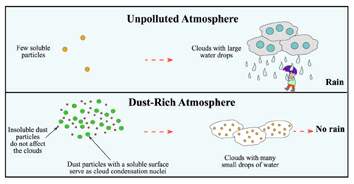Are you a journalist? Please sign up here for our press releases
Subscribe to our monthly newsletter:

The incurable nomad, dust travels enormous distances. Originating primarily in deserts, dust from Africa may end up in Florida, while dust from China can be found in California. Dust particles floating in the air absorb incoming solar radiation as well as radiation emitted by Earth's surface. In this sense, their environmental impact is similar to that of greenhouse gases. The temperature on Earth rises when the ground absorbs visible solar radiation and, in turn, radiates heat. This radiation is partly absorbed by atmospheric greenhouse gases, such as water vapor, carbon dioxide, and ozone and consequently does not dissipate into outer space. Known as the "greenhouse effect," this process occurs naturally and is essential for the existence of life on Earth.
In contrast, however, to the absorption of heat radiated from the ground by greenhouse gases, dust particles also absorb and disperse incoming solar radiation, so that their climatic impact is more complex. The chemical composition of dust particles affects various biological systems and environmental processes. For example, when dust particles contain iron, they absorb more solar radiation. Iron-rich dust particles are also an important nutrient for plankton. (Greek for "drifters," these microscopic oceanic organisms form the base of the aquatic food chain and are estimated to account for much of the atmospheric oxygen produced.) However, when these dust particles reach densely populated areas, the dust-borne iron can become a health hazard, causing the formation of free radicals that attack lung tissue.
Seeking to better understand how the chemical composition of dust particle affects atmospheric and environmental processes, Dr. Yinon Rudich and graduate student Alla Falkovich of the Weizmann Institute's Environmental Sciences and Energy Research Department have conducted a series of studies using a novel approach. They focused on the impact of atmospheric aerosols and dust particles on clouds - one of today's greatest challenges in piecing together the factors affecting the climate on Earth.
Using an electron microscope and a system they developed based on mass spectroscopy, the research team set out with several ends in mind: to identify and analyze the chemical properties of dust particles originating in the Sahara desert, to characterize the organic materials attached to these dust particles, and to determine where a particular element is mainly concentrated - on the particle's surface or at its center. Studying particles collected during a severe dust storm in Israel in March 1998, the scientists found that these particles are covered with iron and sulphur (sulphur is usually found in acids and salts that dissolve in water). In these samples, the lack of sea salt particles and sulfate aerosols (which commonly influence cloud properties) led to the conclusion that the sulphur coating the dust particles had originated from the soil of the source region. In other words, the sulphur arrived in the atmosphere via a natural dust storm and not because of an interaction between dust particles and polluted air, as had been earlier believed.
The presence of a soluble material on the surface of particles is key to understanding the effect of dust on clouds. To probe this effect, the scientists collaborated with Prof. Daniel Rosenfeld of the Hebrew University of Jerusalem to analyze data from the same cloud and rain system obtained through research satellites and aircraft. By combining these data with the results of the chemical analysis, they found that clouds formed in a dust-rich area did not produce rain, whereas clouds outside the area influenced by dust did. Simply put, dust storms inhibit rain formation.

The researchers concluded that the coated dust particles serve as cloud-condensation nuclei around which water drops form. The presence of many cloud-condensation nuclei in the air leads to the formation of clouds with a large number of small drops of water. In such clouds, the coalescence of drops - essential for an increase in droplet size and the production of rain - is blocked. Thus a high concentration of atmospheric dust reduces rainfall; this in turn leads to parched soils, which then cause the formation of more dust, and so on. This feedback mechanism between dust and rainfall may explain the desertification process taking place in the Sahel (a region of Africa, south of the Sahara, from Senegal eastward to Sudan. In this respect, it resembles the effect of forest fires raging in Indonesia and in the Amazon basin on rainfall in these areas. The fires release into the atmosphere large quantities of aerosols, whose solid or liquid components function as cloud-condensation nuclei, reducing rainfall.
According to Rudich, the link between dust particles and cloud properties affects climatic phenomena in many additional ways. In the coming years, such links and their interpretation will be at the center of studies conducted by researchers at the Weizmann Institute and at other institutions in Israel and around the world.